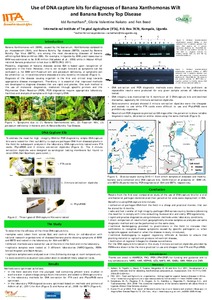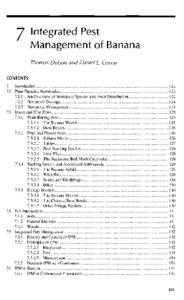| dc.contributor.author | Gold, C. |
| dc.contributor.author | Karamura, E. |
| dc.contributor.author | Kiggundu, A. |
| dc.contributor.author | Abera, A. |
| dc.contributor.author | Bagamba, F. |
| dc.contributor.author | Wejuli, M. |
| dc.contributor.author | Karamura, D. |
| dc.contributor.author | Ssendge, R. |
| dc.contributor.author | Kalyebara, R. |
| dc.date.accessioned | 2019-12-04T11:21:05Z |
| dc.date.available | 2019-12-04T11:21:05Z |
| dc.date.issued | 2000 |
| dc.identifier.citation | Gold, C., Karamura, E., Kiggundu, A., Abera, A., Bagamba, F., Wejuli, M., ... & Kalyebara, R. (2000). Geographic shifts in highland banana production in Uganda. Acta Horticulturae, 540, 55-62. |
| dc.identifier.issn | 0567-7572 |
| dc.identifier.uri | https://hdl.handle.net/20.500.12478/3661 |
| dc.description.abstract | Between 1970 and 1990, highland green cooking banana production rapidly declined in the traditional growing areas in the central region, while during the same period banana production expanded in the country's southwest. Thus, Kampala's growing urban market for banana became dependent upon new growing areas. The recent failure of banana in central Uganda has led to apprehension about its sustainability in the southwest. Therefore, a multi-disciplinary study was conducted at nine central and six southwestern sites to document shifts in highland banana production and to elucidate the driving forces behind these shifts. Cooking banana production in central Uganda sites fell from 18% of total food crop and 7% of total cash crop production in the 1970s to 4% and 2%, respectively in the 1990s. Farmers identified reduced labor availability and management, increasing pest pressure and declining soil nutrient status as the major causes of decline. On-farm verification confirmed farmers observations: weevil levels were the highest yet found in Uganda while foliar samples indicated nutrient deficiencies in Mg, N, and K. In southwestern Uganda, the importance of cooking banana as a cash crop has quadrupled since 1970. Banana was adopted as a food crop because of ease in production and stability of yield. High yields attracted traders and urban market demand drove further crop expansion. However, concern remains about lack of replenishment of nutrients leaving the farm in the form of fruits sold for market that may lead to a non-sustainability situation similar to that experienced in the central region |
| dc.language.iso | en |
| dc.subject | Banana Marketing |
| dc.subject | Banana Nematodes |
| dc.subject | Banana Weevil |
| dc.subject | Banana Yield Decline |
| dc.subject | Highland Banana |
| dc.subject | Sustainability |
| dc.title | Geographic shifts in highland banana production in Uganda |
| dc.type | Journal Article |
| dc.description.version | Peer Review |
| cg.contributor.affiliation | International Institute of Tropical Agriculture |
| cg.contributor.affiliation | National Agricultural Research Organisation, Uganda |
| cg.coverage.region | Africa |
| cg.coverage.region | East Africa |
| cg.coverage.country | Uganda |
| cg.authorship.types | CGIAR and developing country institute |
| cg.iitasubject | Food Security |
| cg.iitasubject | Markets |
| cg.iitasubject | Plant Breeding |
| cg.iitasubject | Plant Production |
| cg.iitasubject | Smallholder Farmers |
| cg.iitasubject | Farm Management |
| cg.iitasubject | Domestic Trade |
| cg.iitasubject | Livelihoods |
| cg.iitasubject | Genetic Improvement |
| cg.iitasubject | Diseases Control |
| cg.iitasubject | Plant Diseases |
| cg.iitasubject | Pests Of Plant |
| cg.iitasubject | Agribusiness |
| cg.iitasubject | Plant Genetic Resources |
| cg.iitasubject | Banana |
| cg.accessibilitystatus | Limited Access |
| local.dspaceid | 95816 |




